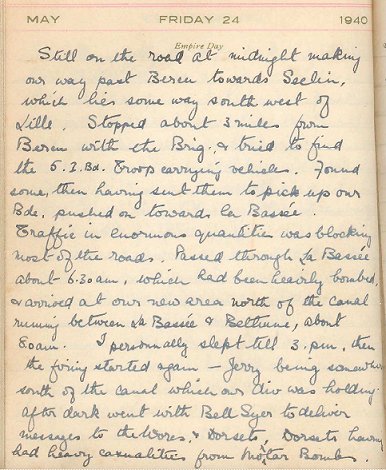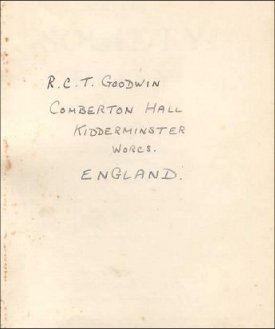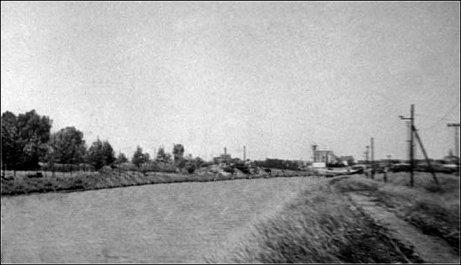Lieut. Ronald Clifford Thomas GOODWIN - Missing Diary (1940)
Ronald Clifford Thomas Goodwin was born in Kidderminster, Worcestershire on the 26th April 1918, son of Stanley Goodwin and Eileen M. Goodwin (née Nichols). His father own a garage business in Kidderminster. The family lived at Comberton Hall, Kidderminster.
Ron was educated at Rossall School, Fleetwood, Lancashire, where he was Cadet Sergeant in the schools O.T.C. Ronald Goodwin was commissioned into the Worcestershire Regiment on the 26th July 1939 and joined the 7th Battalion Worcestershire Regiment. After training with the battalion at Marlborough he sailed with them to France on the ss. Amsterdam troopship on the 14th January 1940, as part of the British Expeditionary Force. He started a diary on the 1st January 1940, recording the day to day activity, which he continued to make entries while in France and Belgium in 1940. However, during the British retreat to Dunkirk his diary was lost during the fighting near the canal at La Bassée on the 26th May 1940. During the German advance and the fighting near the canal a soldier, Horst Kallmeyer, of the 7th Company of the SS Germania Regiment of the SS-VT (Verfügungstruppe) Division found the diary and started to use it himself to keep a record of his experience during the war. For over 65 years nothing was know of the diary until the wife of Horst Kallmeyer died and the grandson found the diary and other papers and photos of his grandfather whilst clearing out his grandparents home. The grandson, who is a Captain with the Hamburg Police, decided to try and find out something about the original owner of the diary, Ronald Goodwin, and contacted this website. As a result we have been able to put together the story of the diary and what happened during the British withdrawal to Dunkirk, with details from both sides. The last entry that Lieutenant Goodwin wrote in his diary before it was lost during the fighting was on the 24th May 1940. the 7th Battalion went into billets around La Quinque Rue, N.W. of La Bassée and rested during remainder of day, spending the night in billets. During the next 2 days heavy shelling and Mortar Fire caused many casualties. |
Lieut. R. C. T. Goodwin (1939) |
Diary of Lieutenant R. C. T. Goodwin |
 |
 |
View of the canal at Le Bassée (May 1940) |
On Friday 24th May 1940 - Horst Kallmeyer wrote
|
Horst Kallmeyer as a Private Soldier |
I then returned to my group. The convoy receives the order to find out whether the bridge over the canal on the left was occupied by the British or had been booby trapped with mines. I now had to creep forward along the same route as I had cycled on before. The bridge was free of enemy. I was sent as a dispatch rider to the company command post. When I came back, the convoy had moved on. After that I advanced forward with U.Scha. Kunze again in the direction of the street Saint V.-Merville. In a house by the bridge on the street to Merville I searched for pair of socks for myself, because mine were wet. Afterwards I found a place behind bridge and relieved myself. Afterwards I went back to my company. When I was about 100 metres from the bridge, there was a sudden howled nearby. English shells, I took cover behind the dam and observed. The impacts were on the bridge, right and left on the shore and in the water. At the moment of the artillery raid a group of our battalion crossed the bridge, 6 dead and several wounded were our losses, a terrible picture. In the middle people were running for cover between the explosions. Water columns of 30 metre height were whirled up. The wooden hut and the toilet I had sat on just 3 minutes before was destroyed by shrapnel. 60 metres from the impacts a battery of our 88mm artillery had a lucky escape, no losses."
"Our company was directed to the right. We move forward to the front line near a partially destroyed bridge. A sad sight. 6 dead companions lie before the bridge with full equipment. The whole group of the M.G. troop and 2 rifle men were killed."
"2-3 Kms before the bridge we dug-in in a wheat field. (Armoured holes in the budget) I had to go back with 2 companions to the castle to get some food from the field kitchen. We went there on bicycles. In the field kitchen and in the castle there was champagne and wine (a whole cellar full). We search the castle, took some food and champagne and return back to our lines. Warm food was greeted with pleasure. As darkness fell outposts were positioned in front of our lines. I went forward at 11.00 o'clock with Meinecke, Ahrend and Schwabenstöcker, after 15 minutes we were told to return. The Tommies were about to attack, we had to go back, because our lines were too thin, we could be cut off too easily."
On the 26th May 1940 the 7th Battalion Worcestershire Regiment War Diary states:
La Bassée canal
Battalion held line of canal. Enemy activity increased - heavy shelling and Mortar Fire intermittently all day. Many casualties, including 2/Lieut. D. G. Goodwin, killed while trying to make contact with the Company on his right. Lieut. J. F. Betts wounded.
Battalion badly situated, having practically no field of fire, and no observation. All our posts could be observed from enemy vantage points on Southern side of canal, and by enemy reconnaissance plane flying over our positions during all hours of daylight. During the late afternoon or evening some enemy must have crossed the canal in the centre of our front. On recce, and while trying to locate "A" Company's position , Commanding Officer, 2 i/c. I.O., and 2/Lieut. R.C.T. Goodwin came upon an enemy post, which opened fire and wounded 2 i/c. (Major R. M. J. Goldie), and I.O. (2/Lieut. R.R. Woodward). During the night one Company 1st Camerons, made a counter attack on our left, but failed to make contact with the enemy, who were reported to have crossed canal.
CLICK HERE TO VIEW A PHOTO GALLERY ABOUT LIEUT. R. C. T. GOODWIN |
CLICK HERE TO READ A FULL TRANSCRIPT OF LIEUT. R. C. T. GOODWIN'S DIARY |
CLICK HERE TO READ A FULL TRANSCRIPT OF HORST KALLMEYER DIARY |




